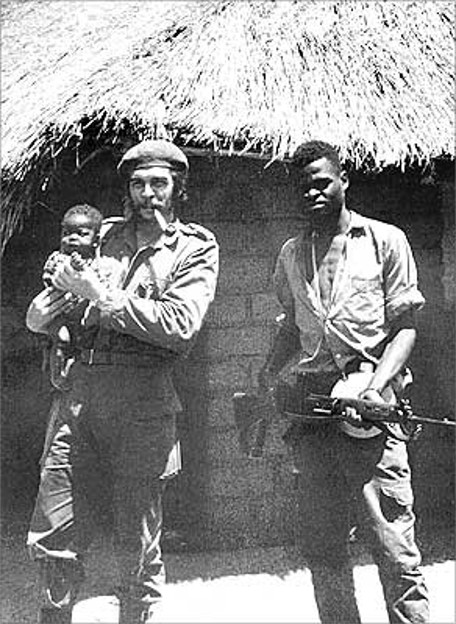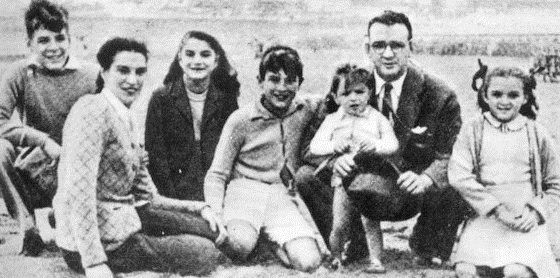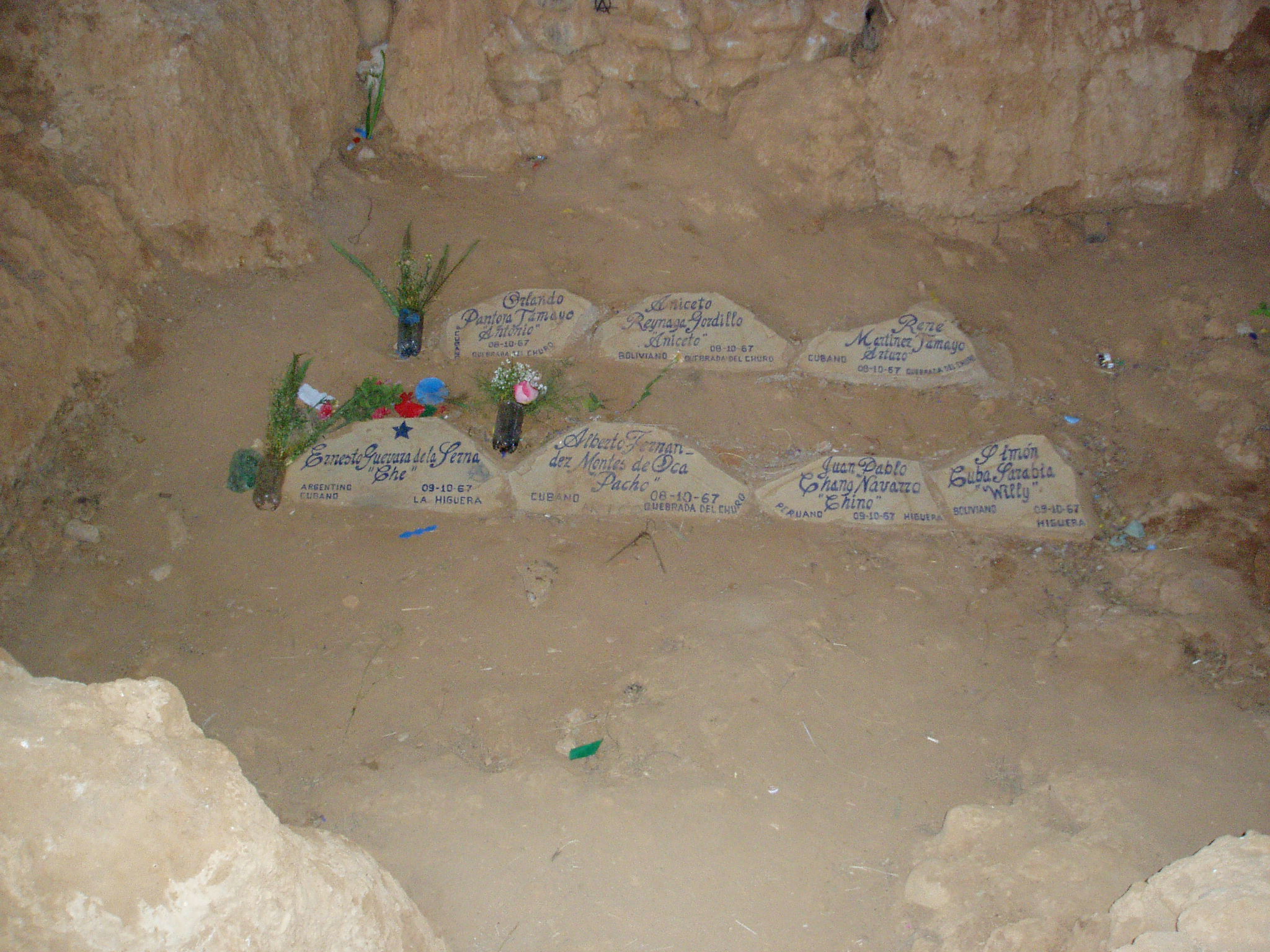|
Simeon Cuba Sarabia
Simeón Cuba Sarabia (15 January 1935 – 9 October 1967), also known as Willy, was a member of the Ñancahuazú guerrilla column led by Che Guevara in Bolivia. Born in the Cochabamba region of Bolivia, he became a leader among tin miners in Huanuni and served as the secretary of organization and secretary of militias of the local mine workers' union. He also carried out various social service activities for the benefit of the miners' families. Cuba Sarabia joined the Communist Party of Bolivia (PCB) but resigned from it in 1965 to become a member of the Bolivian Marxist–Leninist Party which favored armed struggle. When he urged that group to put its principles into practice, he was expelled from it along with Moisés Guevara. It was Moisés Guevara who brought him into Che Guevara's Ñancahuazú guerrilla group in March 1967. Guerrilla fighter Selected to be a member of the "center" unit which was led by Che Guevara himself, Willy came to be known as a disciplined and cou ... [...More Info...] [...Related Items...] OR: [Wikipedia] [Google] [Baidu] |
Simeon Cuba Sarabia
Simeón Cuba Sarabia (15 January 1935 – 9 October 1967), also known as Willy, was a member of the Ñancahuazú guerrilla column led by Che Guevara in Bolivia. Born in the Cochabamba region of Bolivia, he became a leader among tin miners in Huanuni and served as the secretary of organization and secretary of militias of the local mine workers' union. He also carried out various social service activities for the benefit of the miners' families. Cuba Sarabia joined the Communist Party of Bolivia (PCB) but resigned from it in 1965 to become a member of the Bolivian Marxist–Leninist Party which favored armed struggle. When he urged that group to put its principles into practice, he was expelled from it along with Moisés Guevara. It was Moisés Guevara who brought him into Che Guevara's Ñancahuazú guerrilla group in March 1967. Guerrilla fighter Selected to be a member of the "center" unit which was led by Che Guevara himself, Willy came to be known as a disciplined and cou ... [...More Info...] [...Related Items...] OR: [Wikipedia] [Google] [Baidu] |
Ñancahuazú
The Ñancahuazú Guerrilla or Ejército de Liberación Nacional de Bolivia (''National Liberation Army of Bolivia''; ELN) was a group of mainly Bolivian and Cuban guerrillas led by the guerrilla leader Che Guevara which was active in the Cordillera Province of Bolivia from 1966 to 1967. The group established its base camp on a farm across the Ñancahuazú River, a seasonal tributary of the Rio Grande, 250 kilometers southwest of the city of Santa Cruz de la Sierra. The guerrillas intended to work as a ''foco'', a point of armed resistance to be used as a first step to overthrow the Bolivian government and create a socialist state. The guerrillas defeated several Bolivian patrols before they were beaten and Guevara was captured and executed. Only five guerrillas managed to survive, including Harry Villegas, and fled to Chile. Background Congo Crisis Che Guevara was committed to ending American imperialism, and he decided to travel to the Republic of the Congo (Léopoldvi ... [...More Info...] [...Related Items...] OR: [Wikipedia] [Google] [Baidu] |
Che Guevara
Ernesto Che Guevara (; 14 June 1928The date of birth recorded on /upload.wikimedia.org/wikipedia/commons/7/78/Ernesto_Guevara_Acta_de_Nacimiento.jpg his birth certificatewas 14 June 1928, although one tertiary source, (Julia Constenla, quoted by Jon Lee Anderson), asserts that he was actually born on 14 May of that year. Constenla alleges that she was told by Che's mother, Celia de la Serna, that she was already pregnant when she and Ernesto Guevara Lynch were married and that the date on the birth certificate of their son was forged to make it appear that he was born a month later than the actual date to avoid scandal. ( Anderson 1997, pp. 3, 769.) – 9 October 1967) was an Argentine Marxist revolutionary. A major figure of the Cuban Revolution, his stylized visage has become a ubiquitous countercultural symbol of rebellion and global insignia in popular culture. As a young medical student, Guevara traveled throughout South America and was radicalized by the poverty, hunger, ... [...More Info...] [...Related Items...] OR: [Wikipedia] [Google] [Baidu] |
Bolivia
, image_flag = Bandera de Bolivia (Estado).svg , flag_alt = Horizontal tricolor (red, yellow, and green from top to bottom) with the coat of arms of Bolivia in the center , flag_alt2 = 7 × 7 square patchwork with the (top left to bottom right) diagonals forming colored stripes (green, blue, purple, red, orange, yellow, white, green, blue, purple, red, orange, yellow, from top right to bottom left) , other_symbol = , other_symbol_type = Dual flag: , image_coat = Escudo de Bolivia.svg , national_anthem = " National Anthem of Bolivia" , image_map = BOL orthographic.svg , map_width = 220px , alt_map = , image_map2 = , alt_map2 = , map_caption = , capital = La Paz Sucre , largest_city = , official_languages = Spanish , languages_type = Co-official languages , languages ... [...More Info...] [...Related Items...] OR: [Wikipedia] [Google] [Baidu] |
Cochabamba
Cochabamba ( ay, Quchapampa; qu, Quchapampa) is a city and municipality in central Bolivia in a valley in the Andes mountain range. It is the capital of the Cochabamba Department and the fourth largest city in Bolivia, with a population of 630,587 according to the 2012 Bolivian census. Its name is from a compound of the Quechua words ''qucha'' "lake" and '' pampa'', "open plain." Residents of the city and the surrounding areas are commonly referred to as ''cochalas'' or, more formally, ''cochabambinos''. It is known as the "City of Eternal Spring" or "The Garden City" because of its spring-like temperatures all year round. It is also known as "La Llajta," which means "town" in Quechua. It is the largest urban center between the higher capital of La Paz and Santa Cruz de la Sierra in the tropical plains of the east. It sits south-west of the Tunari mountains, and north of the foothills of the Valle Alto. In antiquity, the area featured numerous lakes, which gave the city its ... [...More Info...] [...Related Items...] OR: [Wikipedia] [Google] [Baidu] |
René Barrientos
René Barrientos Ortuño (30 May 1919 – 27 April 1969) was a Bolivian military officer and politician who served as the 47th president of Bolivia twice nonconsecutively from 1964 to 1966 and from 1966 to 1969. During much of his first term, he shared power as co-president with Alfredo Ovando from 1965 to 1966 and prior to that served as the 30th vice president of Bolivia in 1964. General Barrientos came to power after the 1964 Bolivian coup d'état which overthrew the government of President Victor Paz Estenssoro. During his three-year rule, Barrientos and the army suppressed leftist opposition to his regime, including a guerrilla group led by Che Guevara in 1967. Early years Barrientos was a native of Tarata, department of Cochabamba. His father was of Spanish ancestry while his mother was Quechua. After his father died when he was a child, Barrientos was sent to a Franciscan orphanage. He left the orphanage at 12 and attended a private high school while working odd jo ... [...More Info...] [...Related Items...] OR: [Wikipedia] [Google] [Baidu] |
Vallegrande
Vallegrande (''Spanish: "Big Valley"'') is a small colonial town in Bolivia, located in the Department of Santa Cruz, some 125 km (bee-line) southwest of Santa Cruz de la Sierra. It is the capital of the Vallegrande Province and Vallegrande Municipality and serves as a regionally important market town. The town was the first burial site of revolutionary Che Guevara, after his 1967 execution. History Vallegrande was founded by the Spanish in 1612 under the name ''Ciudad de Jesús y Montes Claros de los Caballeros del Vallegrande'' (Town of Jesus and Montes Claros of the knights of Vallegrande). It was intended to serve as a frontier to prevent the constant raids of the Guarani (Chiriguano) warriors that dominated the region. Many of the original inhabitants of Vallegrande were Sephardic and Ashkenazic Jews converted to Catholicism and persecuted by the inquisition in Spain and nearby La Plata and Potosi, for they were suspected to continue to secretly practice Judaism. Othe ... [...More Info...] [...Related Items...] OR: [Wikipedia] [Google] [Baidu] |
Che Guevara Mausoleum
The Che Guevara Mausoleum (, officially ''Conjunto Escultórico Memorial Comandante Ernesto Che Guevara'') is a memorial in Santa Clara, Cuba, located in "Plaza Che Guevara" (Che Guevara Square). It houses the remains of the revolutionary Ernesto "Che" Guevara and twenty-nine of his fellow combatants killed in 1967 during Guevara's attempt to spur an armed uprising in Bolivia. The full area, which contains a bronze 22-foot statue of Guevara, is referred to as the Ernesto Guevara Sculptural Complex. Interview with Cuban sculptor José Delarra. History Historical overview Guevara was buried with full military honors on 17 October 1997 after his remains were discovered in Bolivia, exhumed and returned to Cuba. At the site, there is a museum dedicated to Guevara's life and an eternal flame lit by Fidel Castro in his memory. Santa Clara was chosen as the location in remembrance of Guevara's troops taking the city on December 31, 1958, during the Battle of Santa Clara. The result of th ... [...More Info...] [...Related Items...] OR: [Wikipedia] [Google] [Baidu] |
Santa Clara, Cuba
Santa Clara is the capital city of the Cuban province of Villa Clara Province, Villa Clara. It is centrally located in the province and Cuba. Santa Clara is the List of cities in Cuba, fifth-most populous Cuban city, with a population of nearly 250,000. History Santa Clara was founded by 175 people on July 15, 1689. 138 of them represented two large families already living in the area, who owned land next to the new city. The other 37 came from seven other families and included a priest and governor, all originating in the coastal city of San Juan de los Remedios. The population of Remedios, Cuba, Remedios had to choose between leaving their city, constantly being besieged by pirates, or staying. While most decided to stay, 37 people traveled south to the interior. On June 1, 1689, they arrived at a hill, joining two other families already present at the site. According to tradition, a mass was celebrated under a tamarind tree and Santa Clara was founded. Since then, the pla ... [...More Info...] [...Related Items...] OR: [Wikipedia] [Google] [Baidu] |
Bolivian Trade Unionists
Bolivian may refer to: * Something of, or related to Bolivia ** Bolivian people ** Demographics of Bolivia ** Culture of Bolivia Bolivia is a country in South America, bordered by Brazil to the north and east, Paraguay and Argentina to the south, Chile to the west, and Peru to the west. The cultural development of what is now Bolivia is divided into three distinct period ... * SS ''Bolivian'', a British-built standard cargo ship {{disambig ... [...More Info...] [...Related Items...] OR: [Wikipedia] [Google] [Baidu] |
Executed Communists
Capital punishment, also known as the death penalty, is the state-sanctioned practice of deliberately killing a person as a punishment for an actual or supposed crime In ordinary language, a crime is an unlawful act punishable by a state or other authority. The term ''crime'' does not, in modern criminal law, have any simple and universally accepted definition,Farmer, Lindsay: "Crime, definitions of", in Ca ..., usually following an authorized, rule-governed process to conclude that the person is responsible for violating norms that warrant said punishment. The sentence ordering that an offender is to be punished in such a manner is known as a death sentence, and the act of carrying out the sentence is known as an execution. A prisoner who has been sentenced to death and awaits execution is ''condemned'' and is commonly referred to as being "on death row". Crimes that are punishable by death are known as ''capital crimes'', ''capital offences'', or ''capital felonies'' ... [...More Info...] [...Related Items...] OR: [Wikipedia] [Google] [Baidu] |
Executed Revolutionaries
Capital punishment, also known as the death penalty, is the State (polity), state-sanctioned practice of deliberately killing a person as a punishment for an actual or supposed crime, usually following an authorized, rule-governed process to conclude that the person is responsible for violating norms that warrant said punishment. The sentence (law), sentence ordering that an offender is to be punished in such a manner is known as a death sentence, and the act of carrying out the sentence is known as an execution. A prisoner who has been sentenced to death and awaits execution is ''condemned'' and is commonly referred to as being "on death row". Crimes that are punishable by death are known as ''capital crimes'', ''capital offences'', or ''capital felonies'', and vary depending on the jurisdiction, but commonly include serious Offence against the person, crimes against the person, such as murder, mass murder, Aggravation (law), aggravated cases of rape (often including child s ... [...More Info...] [...Related Items...] OR: [Wikipedia] [Google] [Baidu] |






